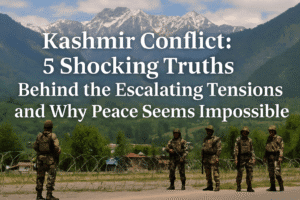Kashmir Conflict: 5 Shocking Truths Behind the Escalating Tensions and Why Peace Seems Impossible
The Kashmir conflict, rooted in the 1947 Partition, remains a persistent struggle between India and Pakistan over territorial claims, exacerbated by religious and national identities. The region has witnessed multiple wars, insurgencies, and human rights violations, with over 47,000 civilians killed since 1989. Despite India’s 2019 constitutional changes aiming to integrate Kashmir, the region remains volatile, with militant groups continuing to destabilize the area.
The 2025 Pahalgam attack highlights the fragile security situation, where both countries’ nuclear capabilities prevent full-scale war but encourage low-intensity conflict. Efforts for peace remain hindered by geopolitical interests, proxy warfare, and a lack of Kashmiri representation. With both nations prioritizing national pride, a lasting solution remains elusive. Until Kashmiris’ voices are included and tensions are de-escalated, the region will continue to be a flashpoint for conflict.

Kashmir Conflict: 5 Shocking Truths Behind the Escalating Tensions and Why Peace Seems Impossible
The scenic Kashmir Valley, nestled in the Himalayas, has been a battleground for India and Pakistan since their independence in 1947. The April 2025 terrorist attack in Pahalgam, which killed 26 Indian tourists, reignited a decades-old feud, underscoring the fragility of a region where peace remains elusive. Here’s a deeper look at the roots of the conflict, its evolution, and why resolution remains a distant hope.
Historical Roots: Partition and the Seeds of Discord
When British India was divided in 1947, Kashmir’s fate was left unresolved. Its Hindu ruler, Maharaja Hari Singh, faced an invasion by Pakistani-backed tribesmen and reluctantly acceded to India in exchange for military aid. This triggered the first Indo-Pakistani war (1947–48), ending with a UN-brokered cease-fire that split Kashmir into Indian- and Pakistani-administered territories. The temporary “Line of Control” (LoC) became a permanent scar, embedding distrust and territorial claims into both nations’ identities.
Wars and Failed Diplomacy
- 1965 War: A second war erupted after Pakistan launched Operation Gibraltar, infiltrating Kashmir to incite rebellion. The conflict ended in stalemate but deepened animosity.
- 1972 Simla Agreement: Following the 1971 Bangladesh Liberation War, India and Pakistan formalized the LoC, pledging peaceful resolution. Yet, the agreement’s promise of bilateral talks never materialized into lasting solutions.
- 1999 Kargil Conflict: Pakistan’s covert incursion into Indian Kashmir nearly sparked nuclear war. The U.S.-mediated withdrawal exposed Pakistan’s military adventurism and India’s resolve to retaliate.
Each conflict reinforced a dangerous pattern: military posturing overshadowing dialogue, leaving Kashmiris caught in the crossfire.
Insurgency and Human Toll
By the late 1980s, discontent over India’s heavy-handed governance and electoral fraud fueled a Pakistan-backed insurgency. Militant groups like Hizbul Mujahideen emerged, blending calls for independence with cross-border terrorism. India responded with counterinsurgency campaigns, leading to decades of violence, disappearances, and allegations of human rights abuses.
The human cost is staggering: over 47,000 civilians killed since 1989, alongside cycles of protests, curfews, and psychological trauma. For Kashmiris, aspirations for self-determination remain unfulfilled, overshadowed by geopolitical gamesmanship.
2019: India’s Constitutional Crackdown
In a watershed moment, India revoked Kashmir’s semi-autonomous status under Article 370, bifurcating the region into federally controlled territories. The move, accompanied by a communications blackout and mass arrests, aimed to integrate Kashmir into India and curb militancy. While violence initially declined, the heavy-handed approach alienated locals and intensified resentment.
Pakistan condemned the move, downgrading diplomatic ties and rallying international criticism. Yet, global powers largely remained silent, prioritizing strategic ties with India over Kashmir’s plight.
2025: A New Flashpoint
The Pahalgam attack underscores the fragility of India’s security gains. Despite Modi’s claims of “normalization,” the assault—claimed by the Pakistan-based Jaish-e-Mohammed—reveals militant groups’ enduring capacity to destabilize the region. India’s threats of retaliation and Pakistan’s denials mirror past crises, raising fears of escalation.
Why Resolution Remains Elusive
- National Identity: For India, Kashmir symbolizes secular sovereignty; for Pakistan, it embodies unfinished Partition goals. Compromise is politically untenable.
- Proxy Warfare: Pakistan’s historical use of militants as “strategic assets” undermines trust, while India’s militarization fuels alienation.
- Nuclear Deterrence: Both nations’ nuclear capabilities deter all-out war but incentivize low-intensity conflict, perpetuating instability.
- International Apathy: Global actors prioritize regional stability over justice for Kashmiris, enabling the status quo.
Pathways to Peace?
- Dialogue Revival: Sustained talks, as seen in the 2003 cease-fire, could reduce border skirmishes.
- Kashmiri Inclusion: Any solution must center Kashmiris’ voices, sidelined for decades.
- Economic Cooperation: Cross-border trade and tourism initiatives could build goodwill.
Yet, with nationalist rhetoric dominating both capitals, diplomatic breakthroughs seem distant.
Conclusion: A Region on the Edge
Kashmir’s tragedy lies in its cyclical suffering—caught between two nations’ pride and geopolitical calculus. The 2025 attack is not an anomaly but a symptom of a deeper malaise. Until India and Pakistan prioritize people over territory, Kashmir will remain a tinderbox, threatening not just regional peace but global security. For now, the valley’s serene beauty belies a history written in blood—a history that shows no signs of ending.
You must be logged in to post a comment.